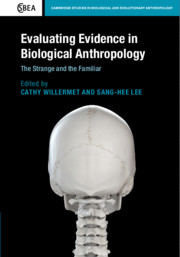Book contents
- Evaluating Evidence in Biological Anthropology
- Cambridge Studies in Biological and Evolutionary Anthropology
- Evaluating Evidence in Biological Anthropology
- Copyright page
- Contents
- Contributors
- Introduction
- Part I The Strange and the Familiar
- Part II (Re)Discovery of Evidence
- 6 (Re)Discovering Paleopathology
- 7 Parsing the Paradox
- 8 Seeing RED
- 9 Paleoanthropology and Analytical Bias
- 10 (Re)Discovering Ancient Hominin Environments
- 11 Discussion and Conclusion
- Index
- References
8 - Seeing RED
A Novel Solution to a Familiar Categorical Data Problem
from Part II - (Re)Discovery of Evidence
Published online by Cambridge University Press: 01 November 2019
- Evaluating Evidence in Biological Anthropology
- Cambridge Studies in Biological and Evolutionary Anthropology
- Evaluating Evidence in Biological Anthropology
- Copyright page
- Contents
- Contributors
- Introduction
- Part I The Strange and the Familiar
- Part II (Re)Discovery of Evidence
- 6 (Re)Discovering Paleopathology
- 7 Parsing the Paradox
- 8 Seeing RED
- 9 Paleoanthropology and Analytical Bias
- 10 (Re)Discovering Ancient Hominin Environments
- 11 Discussion and Conclusion
- Index
- References
Summary
Biological anthropologists interested in population interactions compare biological relationships among living populations, among past populations, and between living and past populations. To do this, we utilize datasets that can be compared equivalently across space and time. One such source of data comes from dental morphological traits, nonmetric characteristics observable on the crown surfaces of teeth. Tooth morphology is largely under genetic control and less affected by environmental factors than many other tissue systems (Hillson 1996; Larsen and Kelley 1991; Scott et al. 2018), and therefore presents an effective dataset with which to trace intrapopulation variation, interpopulation relationships, and microevolution.
- Type
- Chapter
- Information
- Evaluating Evidence in Biological AnthropologyThe Strange and the Familiar, pp. 146 - 173Publisher: Cambridge University PressPrint publication year: 2019



